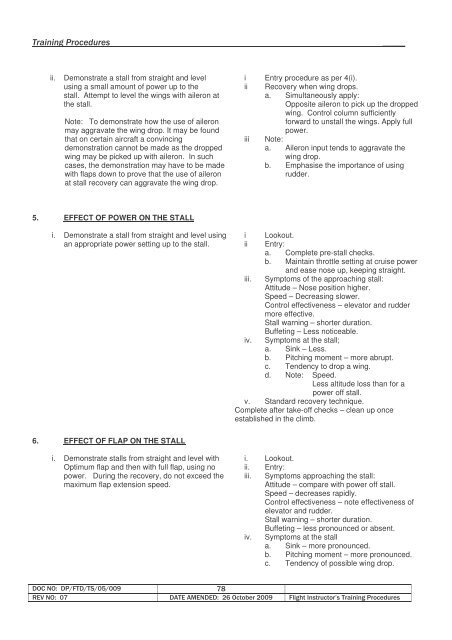Flight Instructors Training Procedures _revised AIC_x
Flight Instructors Training Procedures _revised AIC_x
Flight Instructors Training Procedures _revised AIC_x
You also want an ePaper? Increase the reach of your titles
YUMPU automatically turns print PDFs into web optimized ePapers that Google loves.
5.<br />
6.<br />
ii.<br />
i.<br />
i.<br />
Demonstrate a stall from straight and level<br />
using a small amount of power up to the<br />
stall. Attempt to level the wings with aileron at<br />
the stall.<br />
Note: To demonstrate how the use of aileron<br />
may aggravate the wing drop. It may be found<br />
that on certain aircraft a convincing<br />
demonstration cannot be made as the dropped<br />
wing may be picked up with aileron. In such<br />
cases, the demonstration may have to be made<br />
with flaps down to prove that the use of aileron<br />
at stall recovery can aggravate the wing drop.<br />
EFFECT OF POWER ON THE STALL<br />
Demonstrate a stall from straight and level using<br />
an appropriate power setting up to the stall.<br />
EFFECT OF FLAP ON THE STALL<br />
Demonstrate stalls from straight and level with<br />
Optimum flap and then with full flap, using no<br />
power. During the recovery, do not exceed the<br />
maximum flap extension speed.<br />
,<br />
i Entry procedure as per 4(i).<br />
ii Recovery when wing drops.<br />
a. Simultaneously apply:<br />
Opposite aileron to pick up the dropped<br />
wing. Control column sufficiently<br />
forward to unstall the wings. Apply full<br />
power.<br />
iii Note:<br />
a. Aileron input tends to aggravate the<br />
wing drop.<br />
b. Emphasise the importance of using<br />
rudder.<br />
i Lookout.<br />
ii Entry:<br />
a. Complete pre-stall checks.<br />
b. Maintain throttle setting at cruise power<br />
and ease nose up, keeping straight.<br />
iii. Symptoms of the approaching stall:<br />
Attitude – Nose position higher.<br />
Speed – Decreasing slower.<br />
Control effectiveness – elevator and rudder<br />
more effective.<br />
Stall warning – shorter duration.<br />
Buffeting – Less noticeable.<br />
iv. Symptoms at the stall;<br />
a. Sink – Less.<br />
b. Pitching moment – more abrupt.<br />
c. Tendency to drop a wing.<br />
d. Note: Speed.<br />
Less altitude loss than for a<br />
power off stall.<br />
v. Standard recovery technique.<br />
Complete after take-off checks – clean up once<br />
established in the climb.<br />
i. Lookout.<br />
ii. Entry:<br />
iii. Symptoms approaching the stall:<br />
Attitude – compare with power off stall.<br />
Speed – decreases rapidly.<br />
Control effectiveness – note effectiveness of<br />
elevator and rudder.<br />
Stall warning – shorter duration.<br />
Buffeting – less pronounced or absent.<br />
iv. Symptoms at the stall<br />
a. Sink – more pronounced.<br />
b. Pitching moment – more pronounced.<br />
c. Tendency of possible wing drop.<br />
!"#$ %# &"" '$ #













